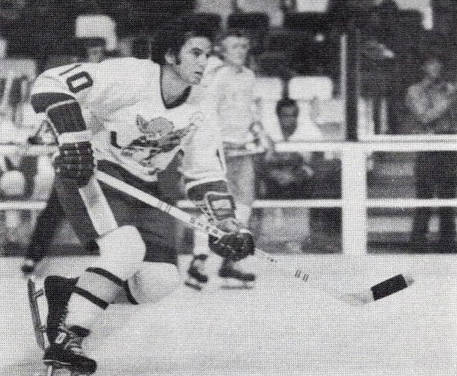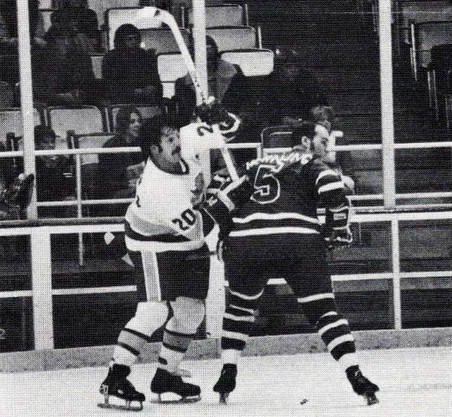Johnson-Hampson Killers
Penalty Killers That Is
BY MIKE LAMEY
The world of sports quickly is becoming a game of specialists.
Football has its special teams of kicking off and punting plus the offensive and defensive units.
Baseball now has a designated pinch hitter, the relief pitcher and late-inning defensive replacements.
In hockey you have the power play unit that gets a lot of attention. But there also is the penalty killers, who play an equally important role in the outcome of a game.
Fighting Saint Coach Harry Neale feels he has the two best penalty killers anywhere in Ted Hampson and Jim Johnson.
“We think that Teddy and Jimmy are the best two in the league,” said Neale and statistics prove him out.
At one point during the season in a 20-game span, Johnson and Hampson were on the ice for only four power play goals by the opposition. During the same stretch, they scored or set up five shorthanded goals.
That’s not a bad percentage. Hampson got three of those early shorthanded goals while blueliner Mike McMahon got the other two.
“They get at least one good scoring chance per penalty,” said Neale. “They work well together and anticipate well.”
Anticipation is the key.
Both Hampson and Johnson are veterans and know what to do with the puck.
The World Hockey Association rule that prohibits shooting the puck the length of the ice during a penalty until you’ve crossed your blueline just makes the job that much tougher on all penalty killing units.
“Sure, that rule makes it tougher,” said Johnson. “Now you have to work the puck out of your end. That means their pointmen can stay right in your end and force you to shoot the puck out.”
A little knowledge of pool or billiards helps. A soft bank shot against the boards that keeps the puck from skidding the length of the ice comes in handy.
“The only problem is that our boards are so fast so it’s not as if we were playing on a pool table,” said Hampson. “The angles are not always true either.”
Hampson admits he likes killing penalties despite the lack of attention from the press and fans.

Ted Hampson
“I enjoy it mainly because it has some importance to it,” said Hampson. “I have done it where ever I’ve played. I remember back with the New York Rangers when Ken Schinkel and I went 17 straight games killing penalties without giving up a goal.”
“The defensemen are the keys. The forwards keep the other team busy enough so not to let them get many chances. But once the other team gets in your zone, especially in front of the net, it is up the defensemen. All the forwards can do it watch the two guys on the point.
“It takes real communication between the four of you plus the goalie,” added the Saint team captain. “The goalie has to let you know which corner he is going to dump the puck into and the same is true of the defensemen.”
Hampson said that Johnson is the key.

Jim Johnson battles Larry Hornung
“When Jim and Mike Antonovich were killing penalties earlier they were getting a lot of chances,” said Hampson. “Now that I’m with Jim and we’re getting chances. It has to be Jim that is doing it.”
Johnson is a familiar face to many Minnesotans. He played in St. Paul in 1963-64 and 1964-65 with the Rangers then again in 1965-66 when the club was in the Central League.
“Scoringwise, I had three pretty good years in St. Paul,” said Johnson. “I averaged 60 points a year and 20 goals. I was called up three times by the New York Rangers, but I hardly played once I got there. New York, even though it was a last place club then, had a set lineup and seldom used a guy even when they called him up.”
“I liked the area here and met a lot of people,” he added. “That is why I decided to come here. I was having money disputes with the Los Angeles Kings at the time, but money wasn’t the reason I left the NHL. I just liked it here and I’m closer to my home in Winnipeg.”
The Johnson household lives in White Bear Lake now the year round.